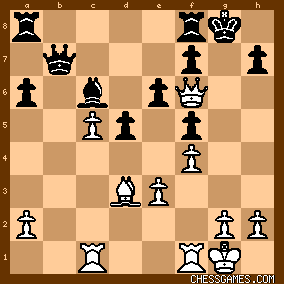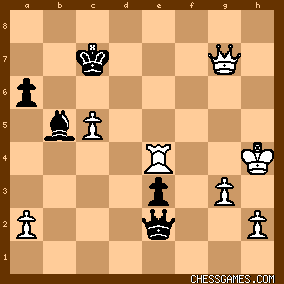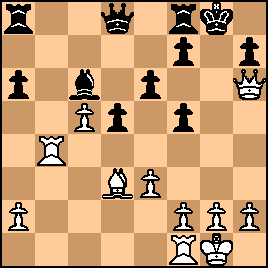|
< Earlier Kibitzing · PAGE 4 OF 4 ·
Later Kibitzing> |
Jun-10-17
 | | Diocletian: I will add this game to my favorites list. I got the first move 16.BxN with the same mating idea in mind: double the pawns and catch the king, but I learned a lot from Hort's masterful execution of the plan. Once the king is exposed, clearly, I knew as well, White needs a rook to join the attack, which was announced by the easily parried mating threat 18.Qh4. How Hort introduces the rook beginning with, at long last, taking the Black bishop 22.cd5, then 25.Rb1 was instructive to me. I consider Hort's repetitions with the Q checks artful and part of the fun, and I find Hort's ending the game at 32.Qh6 with precisely the same mating threat that began the plan high art indeed. Wonderful! No, I don't think Hort calculated the whole thing, but he knew the plan was sound. |
|
| Jun-10-17 | | ChessHigherCat: <veerar: <epicchess> That's funny.And Prague is pronounced?> It's only "h" in non-Russian words that is transliterated as "g" in Russian, for example, Henrik Ibsen = генрик (=Genrik) И́бсен
Sorry, I take it all back, Hort is Czech, not Russian, and I don't speak Czech, except I know they say Praha. Is the Roman letter H pronounced as G in Czech, too? |
|
| Jun-10-17 | | Walter Glattke: My father came from Ukraine, they changes always written g/h into spoken h/g,so Gladkij is spoken Hladkij, but
the Google "Übersetzer" here in Germany
write Praha for Prag and the sound is spoken as "Praha", too, no change in Czech. |
|
| Jun-10-17 | | catlover: <ChessHigherCat> One gets the impression that you are a bit of a linguist. |
|
| Jun-10-17 | | ChessHigherCat: I try to learn most of reasonably easily and widely spoken languages, but Czech is one of the world's most difficult languages and "only" 10 million people speak it so it's not one of my top priorities. Dutch isn't very widely spoken either (only 23 million), but it's easy to learn to read it if you speak German and English. Other than that, I stick to the (non-Asian) biggies. |
|
| Jun-10-17 | | Strelets: <ChessHigherCat> <WalterGlattke> The sound change from Proto-Slavic /g/ to /ɣ/ or /ɦ/ exists in Czech, Ukrainian, and Belarusian and is a pretty good way of telling that one of those three languages are being spoken, just like the nasal vowels in Polish. |
|
| Jun-10-17 | | ChessHigherCat: <Streletz> Good explanation, thanks. It's funny because the other big language that has nasal vowels (besides French) is Portuguese, which can only be explained by osmosis: Polish and Portuguese language books are pushed up next to one another on shelves in alphabetical order :-) |
|
| Jun-10-17 | | devere: 16.Bxf6 gxf6 17.Qg4+ Kh8 18.Qh4 f5 19.Qf6+ Kg8 20.dxc5 Bc6 seems obvious enough. And then what? 21. f4 looks a bit better to me than 21. Rb1 Qc7 22.Rb4, since you can't depend on getting a game-losing blunder like 22...Ra7??. 
click for larger viewAfter 21.f4 threatening 22.Rf3, Black's best may be to give up a pawn with 21...d4, which probably leads to an endgame loss. If instead 21...Rfb8?!! White has to play 22.Bxf5!, since 22.Rf3? Qb2! is equal. The game might then proceed 22.Bxf5! Qb2 ( on 22...exf5 23.Rf3 wins, since 23...Qb2?? now allows checkmate; 22...d4 is an interesting alternative that loses to 23.Bxh7+! Kxh7 24.f5!) 23.Rc3 d4 24.Rc2 Qa3 25.Bxh7+ Kxh7 26.Qxf7+ Kh8 27.Qh5+ Kg7 28.Re2 Qd3 29.f5 exf5 30.Qg5+ Kh7 31.Rf4 Qb1+ 32.Kf2 dxe3+ 33.Kg3 Rb4 34.Qh4+ Kg6 35.Rxb4 Qf1 36.Rd4 (not 36.Rxe3?? f4+ and Black forces checkmate!) Rg8 37.Kh3 Kf7 38.Qh5+ Rg6 39.Kh4! Bb5 40.g3 Qxe2 41.Qh7+ Rg7 42.Qxf5+ Ke7 43.Re4+ Kd8 44.Qf8+ Kc7 45.Qxg7+ 
click for larger view and White is winning. An uncommonly interesting game. The lines that didn't get played are even more interesting than the moves that were actually made. |
|
| Jun-10-17 | | Walter Glattke: I thank for explaination, too, so as
Prague or German: Prag to Praha already has a change from g to h in written style. |
|
Jun-10-17
 | | Fusilli: <stacase: Way too easy for a Saturday.
Were we supposed to see it all the way to the Rook sacrifice 30.Rg4+?> Yes. Even if the decision to play Bxf6 is simple, and what one would do in tournament play without calculating much (and probably what Hort did, hence he repeats moves while he figures out the rest), the point of the puzzles is to calculate and foresee the possible continuations. |
|
| Jun-10-17 | | ChessHigherCat: <devere: After 21.f4 threatening 22.Rf3, Black's best may be to give up a pawn with 21...d4, which probably leads to an endgame loss.> It's not clear that black has to give up a pawn with 21 ...d4 because he's threatening Bxg2 in your diagram position. If 22 Rb1 to drive away the queen, then Qd7 23. exd4 Qd8. White's mating threats are over and black can probably win back the backward e pawn.
f4 was "de very" move I was thinking about too, but on move 22 in the game line. How does black prevent Rf3->g3 there? His only hope is Be7 23. Qxe7 f6 but 24. Rf3 wins anyway (Rf7??? Rg3!) |
|
| Jun-10-17 | | stst: Couple of simpler routes, then a long one.
16.BxN is one main line, then
(A).... gxB, 17.Qg4+ Kh8, 18.Qh5 and Black has no good continuation
(B).....e5 (to guard g4), 17.Qh5 (i)gxB, 18.Qxh7#
17.....(ii)g6, 18.Qh6 Black no defense.
The long line will be subtle:
After 16.BxN g6,17.Qg4 e5, 18.Qh4 g5m, 19.RxB Rc8, 20.Be7 Re8, 21.Qf6 RxR, 22.dxR Qc6, 23.Bd6 Re6, 24.Qd8+ Re8, 25.Qg5 and White should prevail but still got work to do.... see how the game plays out. |
|
| Jun-10-17 | | mel gibson: That was easy but the computer only gives a 1 pawn advantage: 16. Bxf6 (16. Bxf6 (♗g5xf6 g7xf6 ♕d1-g4+ ♔g8-h8 ♕g4-h4
f6-f5 d4xc5 ♖f8-c8 ♖c1-c3 ♕b7-c7 e3-e4 ♕c7-e5 e4xf5 e6xf5 ♖c3-c1 ♕e5-g7
♖f1-e1 ♖c8-c6 g2-g3 ♖a8-c8 ♖e1-e7 ♗d7-e6 ♖e7-a7 ♖c6xc5 ♖c1xc5 ♖c8xc5
♕h4-d8+ ♕g7-g8 ♕d8-d6 ♖c5-c1+ ♔g1-g2) +1.28/19 163) score for white +1.28 depth 19
However move 29 ... Bb5
was a blunder & leads to
mate in 6
29. Rfb1 Bb5
30. Rg4+ (30. Rg4+ (♖b4-g4+ f5xg4 ♕f6-g5+ ♔g8-h8 ♕g5-h6 ♕c7xh2+ ♔g1xh2
g4-g3+) +M6/17 7)
Black should have moved
29...Qe7
29. Rfb1 Bb5 (29. .. Qe7 (♕c7-e7
♕f6xe7 ♖a7xe7 ♗d3xa6 ♔g8-g7 ♖b1-c1 ♖e7-c7 g2-g3 ♖f8-a8 ♖b4-b6 ♖a8-d8 f2-f4
♔g7-f6 ♔g1-f2 d5-d4 ♗a6-d3 d4xe3+ ♔f2xe3 h7-h5 a2-a3 ♖d8-a8 ♖b6-a6 ♖a8-d8)
-1.02/16 19)
score for black -1.02 depth 16 |
|
| Jun-10-17 | | devere: <It's not clear that black has to give up a pawn with 21 ...d4 because he's threatening Bxg2 in your diagram position.> Bxg2 opens the g-file for White, and would lose to Rc2 and a number of other replies. This game is full of rich tactical themes, which is why it is so interesting to analyze. |
|
| Jun-11-17 | | ChessHigherCat: <devere> I shouldn't have got into the pawn thing at all. Here's all I meant: I agree with f4, too, but I think it's much more effective in the game line on move 22, as I proposed above (leads to quick mate instead of gain of material + complications). |
|
| Mar-10-20 | | Gaito: 7....a6? is a mistake known since 1922 (game Alekhine vs. Bogoljubov, Hastings, 1922, 5th round). Alekhine punished that weak move with 8.c5! whereby the square b6 became weak for Black (and strong for White). |
|
| Aug-05-20 | | Chesgambit: easy one for me |
|
| Aug-05-20 | | Chesgambit: 29.Rg4 |
|
| Aug-05-20 | | Chesgambit: Qxb2?Bd6 |
|
| Aug-06-20 | | phantasmagorium: Hmmmm... seing <Gaito>'s post, I wonder how good the GMs at that era were compared with today ones in terms of opening mastery. Here, 7... a6 is played not by just any GM, but by Portisch, who I believe had a reputation as a workaholic and a hard-working opening analyzer. Would a GM of today be as likely to make such a move, I wonder. Somehow I suspect not.
Computers have eaten the entire world - including chess... sigh... |
|
Aug-06-20
 | | perfidious: Portisch was long known for his erudition in the openings. |
|
| Aug-06-20 | | SChesshevsky: < phantasmagorium: ... I wonder how good the GMs at that era were compared with today ones in terms of opening mastery...> Almost certainly those guys were pretty good. Top players in the 70's probably understood the positional plusses and minuses of the openings as well as today's players. Maybe better as they were brought up with positional understanding. In fact, it was 60's & 70's guys like Fischer, Larsen, Tal, Benko, etc. that helped push a lot of opening ideas to a new level. What about 7...a6? Guessing Portisch probably knew of the Alekhine 1922 game. But definitely knew the games when Alekhine played it himself versus Capablanca in a WC. So he was very likely clear on it's plusses and minuses. Then why did Portisch play it? The 7...a6 line was always a minor sideline in the QGD. Guessing he wanted to get Hort in the 70s way "out of book". Think he also wanted to try 11...Qxb2 which might've been something he cooked up. Wondering if 15...Bxc5 allowing the shattered pawns and weak king was planned with the expectation that drawing was still a real possibility? Don't know. But he clearly missed something somewhere after 15. Nxc5. Think the game result was a lot less Portisch blundered with 7...a6 and more that he knew the risks and wanted to get Hort "out of book" and experiment with ...Qxb2. Unfortunately, an experiment that went bad well after 7...a6. Still see plenty of the "out of book" and experiments going bad in today's game as well. But with computers help for safety, they don't usually blow up so quickly or noticeably. |
|
| Aug-15-21 | | Gaito: <Mar-10-20 Gaito: 7....a6? is a mistake known since 1922 (game Alekhine vs. Bogoljubov, Hastings, 1922, 5th round). Alekhine punished that weak move with 8.c5! whereby the square b6 became weak for Black (and strong for White).> Sorry. On second thoughts I believe that I must correct my own previous comment about <"7...a6 possibly being a mistake or an inferior move">. Nothing of the sort. And 8.c5 is not a "refutation" or anything like that, it is just a reasonable option. If it had really been a "refutation", as I wrote in my previous comment, then I would be unable to explain why in the 13th, 15th, 17th 19th and 21st games of the match Capablanca vs. Alekhine, B.A., 1927 Alekhine himself played 7...a6 as Black, and Capablanca replied with 8.a3, not with 8.c5. Then in the 23rd game Capablanca changed the move 8.a3 for 8.cxd5 which is the move played by modern engines like Stockfish 14 or Leela Chess Zero. But 8.c5 (Alekhine's choice against Bogoljubov, Hastings 1922) was never played in the 1927 world championship match.
Therefore, I must retract of my previous comment. Sorry.7...a6 is not a mistake. It is a playable move. |
|
| Aug-15-21 | | Olavi: <Gaito> The next year Portisch was on the other side of the board and routed Petrosian terribly. Portisch vs Petrosian, 1974 These two games pretty much put 7...a6 out of use - well, 9.Bd3 e5 is the playable line. |
|
| Dec-19-24 | | FM David H. Levin: <<avidfan>: 26...Qc7-d8 was needed to challenge White domination of dark squares.> Hi, <avidfan>. On 26...Qd8, White seems to win by 27. Qh6, 
click for larger viewthreatening 28. Rh4, 28. Rg4+, or 28. Bxf5.
26...Ra7 might have been intended to buttress the second rank in preparation for ...Qd8. As noted earlier, the best defense (after 26. Rb4) seems to be 26...Bb5. |
|
 |
 |
|
< Earlier Kibitzing · PAGE 4 OF 4 ·
Later Kibitzing> |
|
|
|





